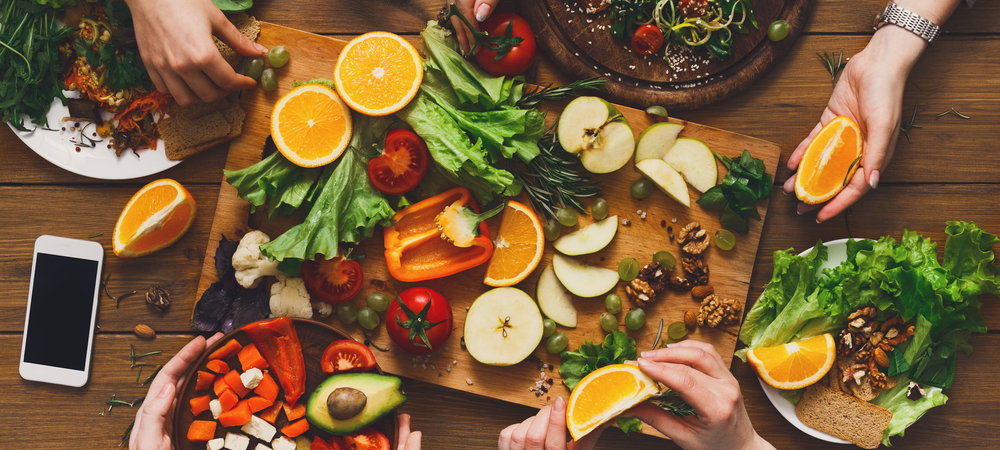
Confused about what kinds of food you should be eating for your health? A healthy eating plan can help. A healthy eating plan should include foods from all the food groups so that you get all of the essential vitamins, minerals, and nutrients you need. This page breaks down the amount of each food group women at different ages should get each day. We've also included examples of common foods to show you how easy it can be to meet your daily needs.
The eating plan listed below is based on a 2,200-calorie eating plan for moderately active women.
Fruits (whole fruit = one cup): two cups
- Example: one apple, one orange
Vegetables: three cups
- Example: one cup of black beans, one and a half cups of leafy salad greens, six baby carrots
Proteins: six ounces
- Example: half a cup of baked beans or one small steak (five and a half ounces), half an ounce of almonds
Grains (at least half should be whole grains): seven ounces
- Example: one cup of cereal, two slices of bread, one cup of pasta, one mini bag of unbuttered microwave popcorn
Dairy: three cups
- Example: one cup of low-fat milk, one eight-ounce container of yogurt, one and a half ounces of cheese, or equal amounts of calcium-fortified dairy-free products
Fats/Oils: 29 grams, or about six teaspoons
- Example: one tablespoon of canola oil, half a medium avocado
The eating plan listed below is based on a 2,200-calorie eating plan for moderately active women.
Fruits (whole fruit = one cup): two cups
- Example: one cup of grapes, one mixed fruit cup
Vegetables: two and a half cups
- Example: one cup of cooked broccoli, one large sweet potato, half a chopped red bell pepper
Proteins: five and a half ounces
- Example: two eggs, half a cup of baked beans, one small steak
Grains (at least half should be whole grains): six ounces
- Example: one cup of cereal, two slices of bread, half a cup of pasta, one mini bag of unbuttered microwave popcorn
Dairy: three cups
- Example: one cup of low-fat milk, one eight-ounce container of yogurt, one and a half ounces of cheese, or equal amounts of calcium-fortified dairy-free products
Fats/Oils: 27 grams, or about five teaspoons
- Example: one tablespoon of peanut butter, one ounce of almonds, one teaspoon of olive oil
The eating plan listed below is based on a 1,800-calorie eating plan for moderately active women.
Fruits (whole fruit = one cup): one and a half cups
- Example: one banana, one snack container of applesauce
Vegetables: two and a half cups
- Example: one cup of cooked green beans, one medium potato, half a baked acorn squash
Proteins: five ounces
- Example: half a chicken breast, one tablespoon of peanut butter, one fourth cup of black beans
Grains (at least half should be whole grains): six ounces
- Example: one cup of cereal, two slices of bread, half a cup of pasta, one mini bag of unbuttered microwave popcorn
Dairy: three cups
- Example: one cup of low-fat milk, one eight-ounce container of yogurt, one and a half ounces of cheese, or equal amounts of calcium-fortified dairy-free products
Fats/Oils: 24 grams, or less than five teaspoons
- Example: one tablespoon of peanut butter, one ounce of almonds
Start small with just one goal, and once you’ve figured out how to meet that goal most days of the week, pick another small goal. You’ll have a healthy eating plan in place before you know it!
- Buy one piece of whole fruit at the grocery store for each day of the week.
- Add at least one vegetable to one of your meals each day.
- Switch your favorite yogurt for a plain yogurt with whole fruit.
- Drink water with lemon rather than sugar-sweetened beverages.
- Add a premade salad to your dinner most nights of the week.
- Buy one less treat or splurge food at the store (chips, cookies, ice cream, etc.) than you normally would.
- Ask for brown rice instead of white rice when you order Chinese food.
- Put out a bowl of whole fruit on your kitchen counter.
- Buy seafood instead of beef or pork for one dinner a week.
- Plan a meatless meal using beans or tofu once a week.
- Switch a sugary breakfast item (sugary cereal, muffin, doughnut, etc.) with a whole-grain or protein item like oatmeal, whole-wheat toast, or an egg.
- Ask friends or family for their favorite healthy recipes.
- Order thin-crust or whole-wheat pizza.
- Buy healthy snacks (nuts, dried fruit, whole-wheat crackers, low-fat cheese, precut vegetables, whole fruit, etc.) to have ready when you get hungry.
- Go grocery shopping with a list of healthy options.
- Use the salad bar at work, school, or restaurants to get more vegetables that day.
- Switch from using butter to cook to using olive oil or other healthier oils.
References
- U.S. Department of Agriculture. (2016). Dietary Guidelines for Americans, Tables A2-1 and A3-1.
Sources
The Office on Women's Health in the U.S. Department of Health and Human Services
Content last updated on December 7, 2018
